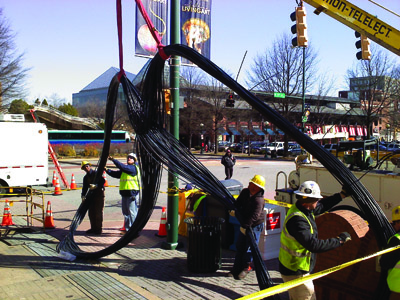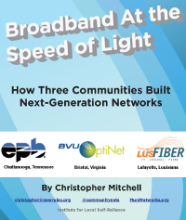
Fast, affordable Internet access for all.

This is the transcript for episode 246 of the Community Broadband Bits Podcast. Christopher Mitchell interviews Eric Lampland of Lookout Point Communications at the Iowa Association of Municipal Utilities. They discuss the importance of due diligence and feasibility studies. Listen to this episode here.
Eric Lampland: The first thing, however, I would suggest that you do is to know who you are as a city, to know exactly where you stand in your own personal knowledge about this kind of activity.
Lisa Gonzalez: This is Episode 246 of the Community Broadband Bits Podcast from the Institute for Local Self-Reliance. I'm Lisa Gonzalez. We're bringing back Eric Lampland to the show this week. For those of you who are regular listeners, you'll recognize Eric's voice from Episodes 80 and 128. He's the founder of Lookout Point Communications and his firm has consulted for a number of communities and other entities across the country. Eric has also worked with us on research projects. In this episode, he and Christopher have a discussion about feasibility studies. When communities decide it's time to make changes to improve local connectivity, they typically need to engage a consulting firm to provide a feasibility study that's unique to their situation. As you'll hear in the interview, just knowing where to start can be confusing. Eric and Chris tackle some of the questions local communities should consider when they're ready to take this step. What should they look for in a quality consultant? What should they ask for in a feasibility study? And what are some common challenges they face? For any local community where investment and better connectivity is a possibility, this interview is worth a bookmark. Learn more about Eric's firm at LookoutPt.com. Now here are Eric Lampland, founder of Lookout Point Communications, and Christopher talking about feasibility studies for local communities.

After discussing this issue time and time again, with community after community, we finally recorded our thoughts on how communities should get started when considering a community network. Eric Lampland, the guy behind Lookout Point Communications, is our guest on Community Broadband Bits podcast episode 246.
We talk about common mistakes and the importance of developing a comprehensive vision when evaluating an investment or partnership to improve Internet access.
We also talk a little about the importance of some technical knowledge and having at least one person championing the effort. This is not something a consultant can do for you - someone in the community has to take ownership and responsibility.
These are very important considerations for any community considering what it should be doing in the modern era.
Eric has also been a guest on Episode 128 "Open Access and Incumbent Challenges" and Episode 84 "Justifying a Network with Indirect Cost Savings."
This show is 33 minutes long and can be played on this page or via Apple Podcasts or the tool of your choice using this feed.
Transcript below.
We want your feedback and suggestions for the show-please e-mail us or leave a comment below.
Listen to other episodes here or view all episodes in our index. See other podcasts from the Institute for Local Self-Reliance here.
Thanks to Break the Bans for the music. The song is Escape and is licensed under a Creative Commons Attribution (3.0) license.
Lesson 1: Google built its own network. It isn't leasing connections or services from big telecommunications companies. Building your own network gives you more control -- both of technology and pricing. Lesson 2: Google uses fiber-optics. These connections are reliable and have the highest capacity of any communications medium. The homes in Kansas City are connected via fiber whereas Time Warner Cable, CenturyLink, and others continue to rely on last-generation technologies because they are delaying investment in modern technology to boost their profits.
 Others have already followed these lessons but are not able to offer their gig for such a low prices. To understand why, let's start with some basics. I'm hypothetically starting Anytown Fiber Net in my neighborhood and I want to offer a gig.
Others have already followed these lessons but are not able to offer their gig for such a low prices. To understand why, let's start with some basics. I'm hypothetically starting Anytown Fiber Net in my neighborhood and I want to offer a gig.
If you are not yet familiar with Mount Pleasant, here’s a chance to learn about one of DC’s most vibrant neighborhoods. It’s a diverse area not far from downtown DC, featuring a main street lined with locally-owned businesses. Many of these shops and restaurants are owned and run by the area’s large Latino community, which has long been central to shaping the neighborhood’s character. However, over the past decade rising housing prices have pushed many in the Latino community east towards Georgia Avenue.
In May, I moved to Mount Pleasant and started to learn about the area. In order to encourage community-building and local empowerment and to increase local information-sharing and opportunities for civic engagement, I decided to use skills and ideas garnered from my work at the Open Technology Initiative to organize a community wireless network. Despite my excitement to get started, I didn’t want to rush in without first connecting with the people, the histories, networks, skill sets, and local knowledge already present in the community.
My first step was technical: with the help of my OTI colleagues, I specified the hardware for the network and prepared the technology for installation. The first-stage plan was to install a few “nodes” (wireless access points) in order to establish the form and structure of the mesh network - open, interoperable, unfiltered, and decentralized. Then, at the Mount Pleasant Farmers Market, I handed out fliers directing people to an online survey gauging their interest in organizing a community wireless network in the neighborhood. I also posted a few of the fliers in local businesses on Mount Pleasant Street. But I needed to go deeper in order to really connect with the existing social networks of people and projects.
Adesta is responsible for 80 percent of EPB's fiber-to-the-home installations, according to Lansford, project manager for Adesta. EPB itself performs the remaining 20 percent, as well as trouble calls. Beginning in June 2009, Adesta ramped up from a one-man office to more than 120 locally hired technicians, and now performs an average of 500 installations per week, or about 100 every day, he said.At the end of October, when the article was written, Adesta had hired some 123 technicians - more than twice as many as they originally expected to need. Perhaps the largest advantage of contracting with a company like Adesta for connecting subscribers is the company's ability to quickly hire more technicians as demand increases. Civil service rules for hiring can hamper hiring when all installs are done in-house. EPB directly employes some thirty installers. Chattanooga closely supervises the training and quality of work from the contracted technicians. Perhaps the biggest downside to hiring outside contractors for this work is the potential for technicians not being invested in the satisfaction of the customer or rushing from install to install to maximize their income. In Chattanooga, they expect technicians to do two installs per day to avoid encouraging shortcuts. In talking with an employee of another muni fiber network, he was amazed at the efficiency of Chattanooga's backoffice processes. The Times Free Press was also impressed:
From a control room in EPB, Abed manages every call that goes out, and knows the location of EPB and Adesta trucks at all times. A computer assigns work based on efficiency, and trouble calls are automatically routed to the nearest available unit.Even in Chattanooga, which has had more of a smooth roll-out than most, getting into apartment buildings (MDU) is difficult:
In addition to servicing homes and businesses, EPB and Adesta have begun rolling out service to apartments as well, he said, addressing a key hole in their service.